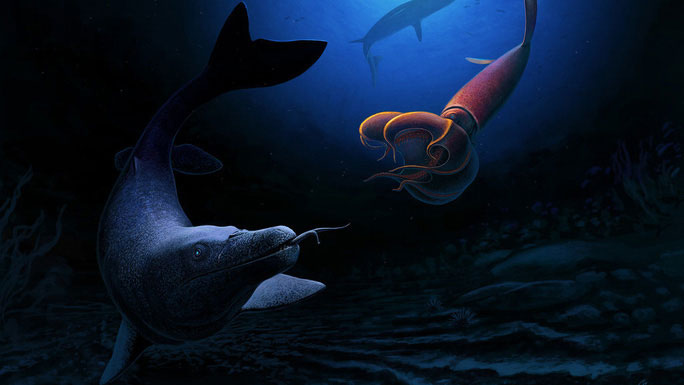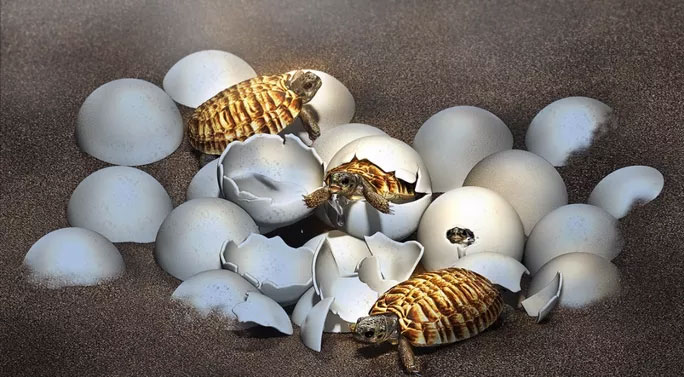Our Earth is a 'monster planet' with terrifying 'companions' of dinosaurs
Paleontological findings over the past year have shown that Earth is not simply a world of dinosaurs in the Triassic - Jurassic - Cretaceous periods, but an extremely diverse monster planet.
1. Sea monsters are relatives of dinosaurs, snakes, dragons

New species of spear dragon
Pluridens serpentis, a new species whose fossil has just been unearthed in Morocco looks like a giant and monstrous dolphin. It has long, thin jaws with more than 100 sharp fangs to bite small prey such as fish and squid, a body up to 8 meters long.
The team led by the University of Bath (UK) said this creature is a mosasaur and is related to dinosaurs, snakes and dragons.
2. Beast Turtle

Graphic image depicting a monster turtle when it is just hatched
A Chinese farmer discovered strange eggs in 2018 and donated them to a university, but the truth about them will not be revealed until 2021. The eggs belong to Yuchelys nanyagensis, a "beast" turtle that went extinct along with all the dinosaurs on Earth during the Chicxulub asteroid disaster 66 million years ago.
According to associate professor Darla Zelenitsky from the University of Calgary in Canada, a member of the research team, the embryos in the eggs, which are up to 90 million years old, have formed 85%. The embryos help scientists calculate the size of the adult: just the length of the carapace has reached 1.6 meters.
3. Pterodactyl with dragon head

Thapunngaka shawi
Research published in the Journal of Vertebrate Paleontology of the University of Queensland (Australia) introduces a terrible flying creature with a wingspan of 7 meters, a 1-meter-long head and a set of 40 razor-sharp teeth, which is no less dangerous. crocodile. It was a pterosaur, named Thapunngaka shawi. And scientists likened it to a real-life dragon.
4. The 80 Jaw Jurassic Monster, Still Alive

Close-up of 80 jaws monster
Ophiojura exbodi, distantly related to starfish, branched off from its closest relative in the early Jurassic, then remained evolutionary intact for 180 million years.
The creature was first discovered by scientists from the French Museum of Natural History in 2011 in the cold, dark waters of the bottom of the South Pacific Ocean, then took years to find more evidence, species identifier.
The full study of it will not be published until June 2021 in Proceedings of the Royal Society B.
5. Giant fish dragon

Close-up of 10 meter long fish dragon fossil
Temnodontosaurus trigonodon is probably the largest ichthyosaur fossil in the world. This monster is up to 10 meters long, 180 million years old, discovered in Rutland Water Nature Reserve (UK).
In the UK, the fish dragon is also known by a mythical name "sea dragon", meaning "sea dragon". The ichthyosaur is a species that has existed with the dinosaurs during all three periods of the Three Dieps - Jurassic and Phat Trang.
- Discover the most terrifying monster of the planet under the ocean
- The 9th planet can cause great extinction on Earth
- Earth changed dramatically, giving birth to a series of super-terrifying 'monsters'
- The most terrifying tourist destinations on the planet
- Decode secret million years of the most giant monster on Earth
- Mysterious skinhead monster in Japanese legend
- Fossil detection of predators before dinosaurs
- New discovery of planet named
- The first dinosaurs appeared on Earth
- Dinosaurs heat the Earth?
- Discovered the most dangerous region of death on Earth: 'Monster Sanctuary'
- Surprising truth about the new 'tyrant Nano' monster remains
 Discovered an ancient centipede fossil 99 million years old
Discovered an ancient centipede fossil 99 million years old Discovered bat-like dinosaurs in China
Discovered bat-like dinosaurs in China Discovered a 200-year-old bronze cannon of the coast
Discovered a 200-year-old bronze cannon of the coast Discover 305 million-year-old spider fossils
Discover 305 million-year-old spider fossils